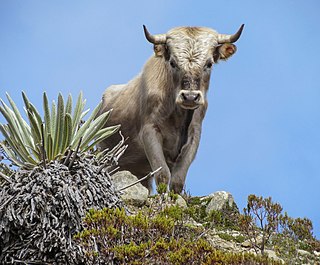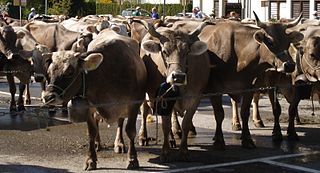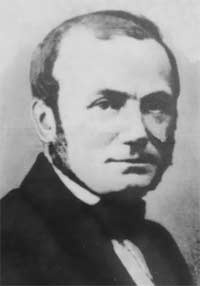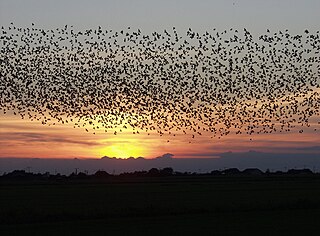
Macquarie Island is an island in the southwestern Pacific Ocean, about halfway between New Zealand and Antarctica. Regionally part of Oceania and politically a part of Tasmania, Australia, since 1900, it became a Tasmanian State Reserve in 1978 and was inscribed as a UNESCO World Heritage Site in 1997.

A feral animal or plant is one that lives in the wild but is descended from domesticated individuals. As with an introduced species, the introduction of feral animals or plants to non-native regions may disrupt ecosystems and has, in some cases, contributed to extinction of indigenous species. The removal of feral species is a major focus of island restoration.

An introduced species, alien species, exotic species, adventive species, immigrant species, foreign species, non-indigenous species, or non-native species is a species living outside its native distributional range, but which has arrived there by human activity, directly or indirectly, and either deliberately or accidentally. Non-native species can have various effects on the local ecosystem. Introduced species that become established and spread beyond the place of introduction are considered naturalized. The process of human-caused introduction is distinguished from biological colonization, in which species spread to new areas through "natural" (non-human) means such as storms and rafting. The Latin expression neobiota captures the characteristic that these species are new biota to their environment in terms of established biological network relationships. Neobiota can further be divided into neozoa and neophyta (plants).

Isidore Geoffroy Saint-Hilaire was a French zoologist and an authority on deviation from normal structure. In 1854 he coined the term éthologie (ethology).
Acclimatization or acclimatisation is the process in which an individual organism adjusts to a change in its environment, allowing it to maintain fitness across a range of environmental conditions. Acclimatization occurs in a short period of time, and within the organism's lifetime. This may be a discrete occurrence or may instead represent part of a periodic cycle, such as a mammal shedding heavy winter fur in favor of a lighter summer coat. Organisms can adjust their morphological, behavioral, physical, and/or biochemical traits in response to changes in their environment. While the capacity to acclimate to novel environments has been well documented in thousands of species, researchers still know very little about how and why organisms acclimate the way that they do.
This is a timeline of environmental history of New Zealand. It includes notable events affecting the natural environment of New Zealand as a result of human activity.

Invasive species in Australia are a serious threat to the native biodiversity, and an ongoing cost to Australian agriculture. Numerous species arrived with European maritime exploration and colonisation of Australia and steadily since then.

Conservation in New Zealand has a history associated with both Māori and Europeans. Both groups of people caused a loss of species and both altered their behaviour to a degree after realising their effect on indigenous flora and fauna.
Naturalisation is the ecological phenomenon through which a species, taxon, or population of exotic origin integrates into a given ecosystem, becoming capable of reproducing and growing in it, and proceeds to disseminate spontaneously. In some instances, the presence of a species in a given ecosystem is so ancient that it cannot be presupposed whether it is native or introduced.
A zoological society is a group or organization, often a voluntary association, interested in fields of study related to the animal kingdom. These fields generally include zoology, animal physiology, pathology, veterinary medicine, wildlife conservation, conservation biology, and related topics. Zoological societies are often associated with the operation and/or management of zoos, public aquariums, veterinary hospitals, research institutions, and conservation projects, and with the publication of scientific journals and periodicals. The first such society was the Zoological Society of London, founded in 1826.
David Seth-SmithFZS, MBOU was a British zoologist, wildlife artist, nature broadcaster and author.

The Jardin d'Acclimatation is a 19-hectare (47-acre) children's amusement park located in the northern part of the Bois de Boulogne in Paris, alongside other attractions.
An ecological island is a term used in New Zealand, and increasingly in Australia, to refer to an area of land isolated by natural or artificial means from the surrounding land, where a natural micro-habitat exists amidst a larger differing ecosystem. In New Zealand the term is used to refer to one of several types of nationally protected areas.

Islands, such as the British Isles, can be adversely affected by the introduction of non-native species. Often an island will have several distinct species not present on the nearest mainland, and vice versa. The native flora and fauna of islands which have been isolated for a longer period of time such as New Zealand or Hawaii are more vulnerable than islands such as Great Britain and Ireland, which became isolated more recently.

The common brushtail possum was introduced from Australia to New Zealand, where it has become invasive and a major agricultural and conservation pest.

The American Acclimatization Society was a group founded in New York City in 1871 dedicated to introducing European flora and fauna into North America for both economic and cultural reasons. The group's charter explained its goal was to introduce "such foreign varieties of the animal and vegetable kingdom as may be useful or interesting." Like other acclimatisation societies, the American Acclimatization Society's efforts impacted the natural history of North America, particularly due to its success in introducing invasive bird species.

Acclimatisation societies to naturalise all kinds of new species —as long as they had no harmful effect— were established in New Zealand by European colonists from the 1860s, with the first likely having been established in Auckland around 1861.

The stoat was introduced into New Zealand to control introduced rabbits and hares, but is now a major threat to the native bird population. The natural range of the stoat is limited to parts of the Northern Hemisphere. Immediately before human settlement, New Zealand did not have any land-based mammals apart from bats, but Polynesian and European settlers introduced a wide variety of animals. Rarely, in Southland, the fur of stoats has been reported to turn white, being the fur known as ermine, which adorns royal robes.

The European hedgehog was brought to New Zealand by British colonists in the 1870s as a way to deal with insect pests that had hitched a ride on crops the colonists had brought from their homeland for farming. Long regarded as a gardener’s helper in Britain, the introduction of Hedgehogs seemed a good solution to the lack of natural predators for these pests in New Zealand. They have since spread throughout the country, being absent only in inhospitable environments. The general public has a benign attitude to them in urban environments, but conservationists and regional councils regard them as pests, as they prey on native animals and compete with them for food.

Pierre Carbonnier, was a French scientist, ichthyologist, fish breeder and public Aquarium director. Member of Imperial Society of acclimatization.















